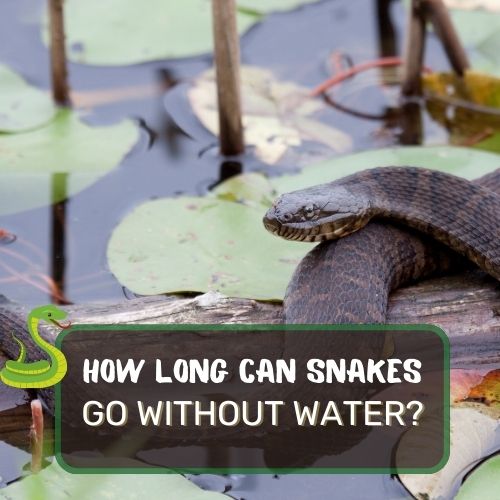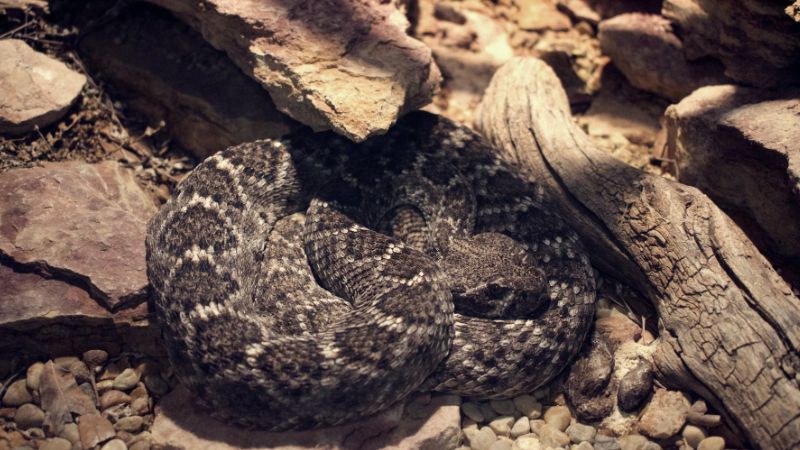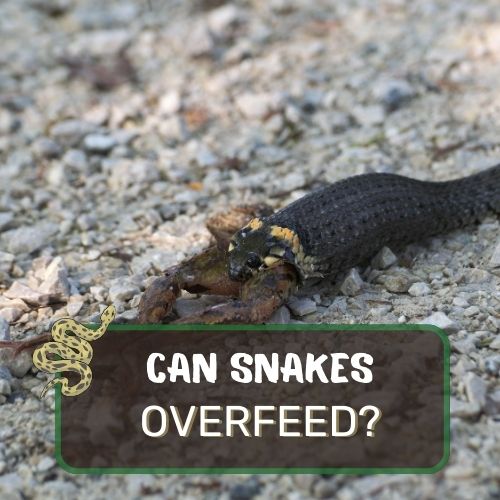
In the intriguing world of reptilian survival, one question emerges: “How long can snakes go without water?”
This article delves into the remarkable adaptability of snakes, exploring the various factors that influence their hydration needs.
From species differences and environmental conditions to size, age, and behavioral patterns, we unravel the intricate web that determines a snake’s endurance without water.
By understanding these factors, readers will gain insights into the captivating mechanisms snakes employ to thrive in arid landscapes, the potential risks of dehydration, and how to ensure proper hydration for both captive and wild serpents.
Join us on this journey as we uncover the secrets behind snakes’ ability to endure water scarcity and emerge resilient amidst challenging conditions.
Table of Contents
- 1 For How Long Until Snakes Get Thirsty? (Short Answer)
- 2 How Long Can Snakes Go Without Water in the Wild?
- 3 Factors Affecting Snakes’ Water Needs
- 4 How Long Can Snakes Go Without Water in Captivity?
- 5 Signs of Dehydration in Snakes
- 6 Strategies for Hydrating Snakes
- 7 Importance of Water for Snake Health
- 8 How to Prevent Dehydration in Snakes
- 9 FAQ
- 10 Conclusion
For How Long Until Snakes Get Thirsty? (Short Answer)
The duration that snakes can go without water varies based on factors like species, size, environment, and health. Some desert-adapted snakes, like the sidewinder rattlesnake, can survive several months to even a year without water. Others, especially those in more humid environments, might require water more frequently. Generally, snakes have evolved various mechanisms to conserve water and adapt to their habitats. It’s crucial to consider these factors and provide access to clean water for captive snakes. In the wild, their survival depends on their ability to find water sources or adapt to water scarcity through specialized physiological and behavioral adaptations.
How Long Can Snakes Go Without Water in the Wild?

When it comes to the fascinating world of snakes, their ability to thrive in varying environments never ceases to amaze.
One burning question that often surfaces is, “How long can snakes go without water?” Well, the answer isn’t as straightforward as you might think.
Different Snake Species and Their Ability to Go Without Water
Snake species exhibit a remarkable diversity in their capacity to endure periods without water. Some species have evolved to be more adept at water conservation, allowing them to withstand extended dry spells.
For instance, desert-dwelling snakes like the sidewinder rattlesnake have developed ingenious ways to minimize water loss through specialized skin scales and behavioral adaptations.
Factors That Affect Snakes’ Water Requirements in Their Natural Habitats
The amount of time a snake can survive without water isn’t solely dependent on its species. Environmental factors play a crucial role as well. Snakes residing in arid regions, like the parched deserts, have adapted to scarce water availability.
On the other hand, snakes found in more humid climates might have different hydration needs due to the prevalence of moisture in the air.
Examples of Snakes Surviving for Extended Periods Without Water
The natural world is full of astonishing stories that underscore the resilience of snakes. Take the Australian desert death adder, for instance.
This venomous serpent can go for months without water by relying on its ability to slow down its metabolism and conserve precious fluids.
Similarly, the African sand boa has been observed surviving in sandy environments for up to a year without access to water sources.
Factors Affecting Snakes’ Water Needs

While some might assume that all snakes uniformly require water, the reality is much more nuanced. Several factors contribute to the varied water needs among different snake species.
Environmental Factors Such as Temperature and Humidity
Just like humans, snakes’ water requirements are influenced by the environment they inhabit. Snakes in hotter climates tend to lose water more rapidly through evaporation. In contrast, those living in cooler, more humid areas might experience slower dehydration rates.
Snake Size and Age as Determinants of Water Needs
The size and age of a snake significantly impact its water needs. Young snakes are generally more delicate and susceptible to dehydration, as their bodies are still developing the mechanisms to efficiently regulate water balance.
Larger snakes, due to their increased surface area, can lose water more quickly and might need to replenish more frequently.
Activity Levels and Metabolic Rate Influencing Water Requirements
The lifestyle of a snake can be a critical determinant in gauging its water requirements. Highly active snakes, which expend more energy, might need to drink more often to maintain their bodily functions.
Additionally, a snake’s metabolic rate, which dictates how quickly it processes nutrients and water, can vary widely across species.
While some species have developed astonishing strategies to combat water scarcity, others might require more frequent hydration.
Understanding the intricate balance between environmental factors, species characteristics, and metabolic processes is key to unraveling the mystery of how long snakes can go without water in the wild.
How Long Can Snakes Go Without Water in Captivity?

The realm of snake care extends beyond the wild, as many enthusiasts keep these enigmatic creatures as pets. But even in controlled environments like captivity, the question lingers: “How long can snakes go without water?”
Guidelines for Providing Water to Pet Snakes in Captivity
When it comes to pet snakes, their hydration needs differ from their wild counterparts. Owners should provide a consistent and accessible water source. This could be a shallow dish that’s easy for the snake to access without causing discomfort.
Potential Risks of Restricting Water Intake for Extended Periods
While snakes in captivity might not face the same water scarcity challenges as those in the wild, restricting their water intake for extended periods can still lead to health issues. Dehydration in captive snakes can impact their digestion, shedding, and overall well-being.
Expert Recommendations for Ensuring Proper Hydration in Captive Snakes
Veterinary experts suggest monitoring your pet snake’s behavior and physical condition to gauge its hydration status. Adjusting the size and location of the water dish to accommodate the snake’s needs can go a long way in promoting proper hydration.
Signs of Dehydration in Snakes

The language of snakes isn’t spoken with words, but rather through their subtle behaviors and physical cues. Recognizing signs of dehydration in snakes is crucial for maintaining their health.
Identifying the Physical and Behavioral Signs of Dehydration in Snakes
Watch out for subtle hints that your snake might be dehydrated. Sunken eyes, wrinkled or loose skin, and lethargic behavior can all be indicators. Changes in coloration or scales that appear dull might also suggest inadequate hydration.
Health Consequences of Prolonged Dehydration in Snakes
Dehydration can take a toll on a snake’s overall well-being. It can lead to difficulties in shedding, digestive problems, and compromised immune function. In severe cases, chronic dehydration might even result in organ damage.
Steps to Take If a Snake Shows Signs of Dehydration
If you notice any signs of dehydration in your pet snake, it’s essential to act promptly. Offering a shallow water dish and providing a more humid environment can help the snake rehydrate. However, severe cases might require professional veterinary care.
In the intricate dance of snake survival, the role of water is both fundamental and complex. Whether in the wild or in captivity, understanding the factors influencing snakes’ hydration needs is pivotal for their well-being.
From the desert’s arid expanses to the cozy corners of terrariums, the question of how long snakes can go without water carries implications that ripple through their unique and mysterious lives.
Strategies for Hydrating Snakes

Hydrating snakes, whether in captivity or in the wild, demands a nuanced approach. Employing proper hydration methods is crucial for maintaining their health and well-being.
Proper Hydration Methods for Captive Snakes
In the realm of pet snake care, providing accessible and clean water sources is paramount. Water dishes that are shallow and easy to access can ensure that your snake can hydrate comfortably.
Additionally, misting the enclosure can elevate humidity levels, supporting overall hydration.
Types of Water Sources That Are Safe for Snakes
For captive snakes, clean and chlorine-free water is a must. Tap water that has been treated or filtered is generally safe. In the wild, snakes might rely on natural sources such as puddles, streams, or even moisture from prey.
Frequency and Quantity of Water Intake for Different Snake Species
Different snake species have varying water requirements. Smaller and more active snakes might need to drink more frequently, while larger snakes with slower metabolisms might not require water as often.
Researching the specific needs of your snake species is crucial for providing the right amount of hydration.
Importance of Water for Snake Health

Water, often taken for granted, is a life-giving force even in the slithering world of snakes. Understanding the importance of water in snake health sheds light on the intricacies of their physiological processes.
The Vital Role Water Plays in Snake Physiological Processes
Water is the conduit through which vital processes in a snake’s body occur. It aids in digestion, allowing enzymes to break down food for absorption.
It also plays a pivotal role in maintaining proper organ function, regulating body temperature, and transporting nutrients throughout the body.
Impacts of Dehydration on Digestion, Shedding, and Overall Health
Dehydration disrupts the delicate balance of a snake’s internal ecosystem. Insufficient water intake can lead to difficulties in digestion, making it harder for the snake to extract nutrients from its meals.
It can also result in incomplete or problematic shedding, where old skin doesn’t slough off properly.
Potential Consequences of Chronic Dehydration in Snakes
Chronic dehydration can have cascading effects on a snake’s health. It weakens the immune system, rendering snakes more susceptible to infections. It can lead to renal issues, affecting the kidneys’ ability to filter waste.
Long-term dehydration can even impact a snake’s longevity, potentially shortening its lifespan.
How to Prevent Dehydration in Snakes

Preventing dehydration in snakes is an active commitment that revolves around maintaining the right conditions for their well-being.
Proper Husbandry Practices to Ensure Snakes Have Access to Adequate Water
For captive snakes, providing a consistent and accessible water source is fundamental. Regularly check and refill water dishes to ensure they are clean and filled. Additionally, consider the snake’s size and activity level when determining water dish placement.
Environmental Factors to Consider for Maintaining Optimal Hydration
Creating a suitable environment is vital for preventing dehydration. Maintain appropriate temperature and humidity levels in the enclosure to mimic the snake’s natural habitat.
A humidity hide or a moist substrate can be particularly beneficial for snakes that require higher humidity.
Monitoring and Adjusting Water Intake Based on Individual Snake Needs
Every snake is unique, and their hydration needs can vary. Observing your snake’s behavior and physical condition can provide valuable insights into its hydration status. Adjust the frequency and quantity of water provided based on your snake’s size, species, and overall health.
FAQ
As the world of snake hydration unveils its intricacies, a series of common questions arise. Let’s delve into the queries that often surface in this enigmatic realm.
How Often Should Snakes Have Water?
The frequency of water intake varies among snake species. Generally, providing access to fresh water at all times is advisable. Smaller, more active snakes might need water more frequently than larger, less active ones.
How Long Can My Ball Python Go Without Water?
Ball pythons, like other snake species, require regular access to water. Depriving them of water for extended periods can lead to health issues. Aim to provide a clean water source for your ball python to drink from as needed.
Do Snakes Need Water?
Absolutely. Water is a fundamental element for a snake’s survival and well-being. It supports essential physiological functions and helps prevent dehydration-related complications.
How Do You Give a Snake Water?
Offering water to a snake involves providing a shallow, easily accessible water dish in their enclosure. Ensure the water is clean, chlorine-free, and regularly replenished. Mist the enclosure to elevate humidity levels, especially for species that require higher humidity.
Is It OK to Spray a Snake with Water?
Misting is a common method to increase humidity in a snake’s enclosure. However, direct misting onto the snake itself is generally not recommended. Snakes absorb moisture through their skin, but soaking them can be stressful and potentially detrimental to their health.
Conclusion
The journey into the world of snakes and their relationship with water unveils a tapestry of marvels. From their astonishing adaptability in the wild to the nuanced care they require in captivity, the story of snake hydration is one of survival, resilience, and understanding.
Appreciating the multifaceted role that water plays in a snake’s life underscores the importance of maintaining proper hydration.
Whether you’re a devoted snake owner or an admirer of the natural world, the answers to the questions surrounding snake hydration unveil a deeper connection to these captivating creatures.
As we navigate the mysteries of snake survival strategies and the crucial role water plays in their existence, we’re reminded of the delicate balance that supports life in its diverse and mesmerizing forms.
Through understanding and respect, we can continue to be stewards of these creatures and appreciate the intricate dance of life that they perform.




0 Comments